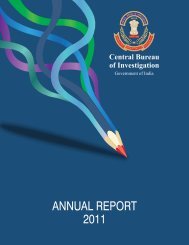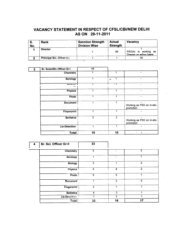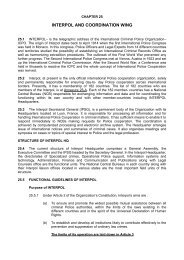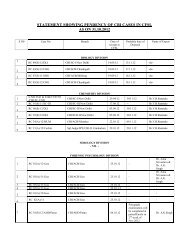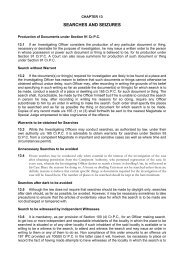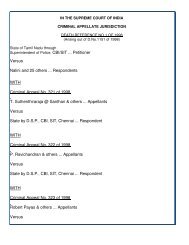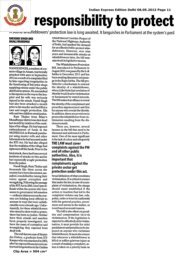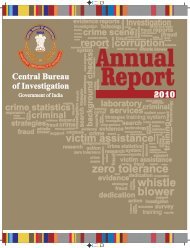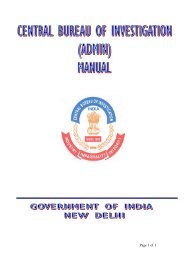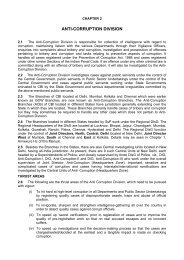CBI Chapt 4 part1 pg 62-89 - Central Bureau of Investigation
CBI Chapt 4 part1 pg 62-89 - Central Bureau of Investigation
CBI Chapt 4 part1 pg 62-89 - Central Bureau of Investigation
You also want an ePaper? Increase the reach of your titles
YUMPU automatically turns print PDFs into web optimized ePapers that Google loves.
GROWTH WITH A DIFFERENCE<br />
In 1968, there was a change <strong>of</strong> guards. On superannuation,<br />
Director D.P. Kohli handed over the charge and command <strong>of</strong><br />
st<br />
his corps to F.V. Arul (31 May, 1968).<br />
During his five year tenure, Shri D.P. Kohli had put<br />
the organization, as indicated above, on a sound footing.<br />
Fortunately, the shape and speed <strong>of</strong> growth <strong>of</strong> the<br />
organization did not diminish in any way during the time <strong>of</strong><br />
D.P. Kohli's successors. They too spared no pains to take the<br />
organization ahead.<br />
The Government had, however, a feeling, and rightly<br />
so, that the <strong>CBI</strong> was in a way overburdened with work.<br />
Hence, they transferred some <strong>of</strong> its work to other<br />
organizations.<br />
The part-work relating to crime records and statistics<br />
was transferred to the National Crime Records <strong>Bureau</strong><br />
(NCRB) and a part concerning research work to the <strong>Bureau</strong><br />
<strong>of</strong> Police Research & Development (BPR&D).<br />
The transfer <strong>of</strong> workload gave a certain feeling <strong>of</strong><br />
relief to the overloaded organization. But it was not destined<br />
to enjoy the relief for long. After a while, some very difficult,<br />
if not very heavy, work came its way from unexpected and<br />
unusual quarters. It somehow happened that the higher<br />
<strong>CBI</strong> Office at Jaipur<br />
70 Mall Road, Ambala Cantonment, Ambala, where one <strong>of</strong> the earliest <strong>CBI</strong> <strong>of</strong>fice was located.<br />
Judiciary, that is, the Supreme Court and High<br />
Courts, impressed by the organization's efficiency<br />
and pr<strong>of</strong>essionalism, started giving complicated<br />
cases 'requiring serious investigations, in some<br />
cases on the prayers <strong>of</strong> the aggrieved parties, and in<br />
some others on their own initiatives'.<br />
As a result, the <strong>CBI</strong>'s basket began to<br />
overflow with crime cases. In view <strong>of</strong> this,<br />
the Government divided the <strong>Investigation</strong><br />
Division into two Divisions, namely, the<br />
Anti-Corruption Division and the Special Crimes<br />
Division. The former dealt with the corruption<br />
cases and the latter with cases <strong>of</strong> conventional and<br />
economic <strong>of</strong>fences.<br />
In 1990s, some special investigating cells<br />
were created to investigate important but highly<br />
complicated cases, for instance, the Special<br />
<strong>Investigation</strong> Team (SIT) to investigate the<br />
Rajiv Gandhi Assassination Case (1991), the Special<br />
<strong>Investigation</strong> Cell-IV (SIC-IV) to investigate the<br />
Babri Masjid Demolition Cases, and the Bank<br />
Securities & Frauds Cell (BS&FC) to investigate the<br />
cases related to bank frauds and securities scams<br />
(1992). In the following year (1993), a Special Task<br />
Force was created to take up investigation relating<br />
to bomb blasts in Bombay.<br />
76<br />
....In Service <strong>of</strong> the Nation....



